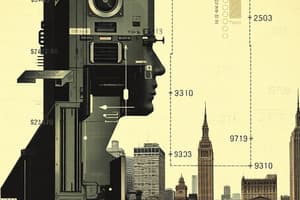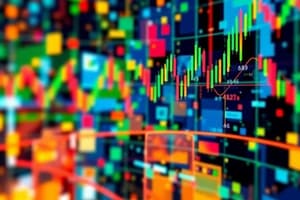Podcast
Questions and Answers
¿Cuál es la función principal del aparato respiratorio segun el texto?
¿Cuál es la función principal del aparato respiratorio segun el texto?
La función principal es el intercambio de gases: aportar oxígeno a la sangre y eliminar el dióxido de carbono producido por el metabolismo.
El _____ _____ es la serie de conductos por los que circula el aire inspirado hasta la superficie alveolar.
El _____ _____ es la serie de conductos por los que circula el aire inspirado hasta la superficie alveolar.
árbol respiratorio
¿Dónde se encuentran las células ciliadas y cuál es su función?
¿Dónde se encuentran las células ciliadas y cuál es su función?
Se encuentran desde la cavidad nasal hasta los bronquiolos más pequeños. Tienen extensiones llamadas cilios que se mueven de forma rítmica para desplazar el moco hacia la faringe-laringe, ayudando a la expulsión de partículas extrañas.
Las células caliciformes se encuentran en la mucosa de las vías respiratorias como la _____ y los _____.
Las células caliciformes se encuentran en la mucosa de las vías respiratorias como la _____ y los _____.
¿Qué funciones tiene el moco secretado por las células caliciformes?
¿Qué funciones tiene el moco secretado por las células caliciformes?
Los neumocitos tipo I son células _____ y _____ que forman una monocapa en las paredes alveolares, permitiendo el _____.
Los neumocitos tipo I son células _____ y _____ que forman una monocapa en las paredes alveolares, permitiendo el _____.
¿Qué tipo de célula pulmonar es responsable de la producción de surfactante?
¿Qué tipo de célula pulmonar es responsable de la producción de surfactante?
¿Cuál es la función del surfactante pulmonar?
¿Cuál es la función del surfactante pulmonar?
Los neumocitos tipo II pueden diferenciarse en neumocitos tipo I si estos últimos resultan dañados.
Los neumocitos tipo II pueden diferenciarse en neumocitos tipo I si estos últimos resultan dañados.
Las células de Clara (o células club) se encuentran en los _____ y participan en la producción de _____ y tienen una función protectora.
Las células de Clara (o células club) se encuentran en los _____ y participan en la producción de _____ y tienen una función protectora.
¿Qué papel juegan las células dendríticas en los pulmones?
¿Qué papel juegan las células dendríticas en los pulmones?
¿Cuál es la función de los macrófagos alveolares?
¿Cuál es la función de los macrófagos alveolares?
Los macrófagos alveolares ayudan a proteger los pulmones de _____.
Los macrófagos alveolares ayudan a proteger los pulmones de _____.
Flashcards
Aparato Respiratorio
Aparato Respiratorio
Series of conduits through which inhaled and exhaled air circulates, plus an area for gas exchange. (alveolar surface)
Ciliated Cells
Ciliated Cells
These cells are found in the nasal cavity, trachea, bronchi, and bronchioles, up to the smallest respiratory pathways. They have extensions called cilia.
Caliciform Cells
Caliciform Cells
These cells are located in the mucosa of the respiratory tract, specifically in the trachea and bronchioles and secrete mucus that traps foreign particles and pathogens.
Type I Pneumocytes
Type I Pneumocytes
Signup and view all the flashcards
Type II Pneumocytes
Type II Pneumocytes
Signup and view all the flashcards
Type II pneumocytes characteristic
Type II pneumocytes characteristic
Signup and view all the flashcards
Clara Cells
Clara Cells
Signup and view all the flashcards
Dendritic Cells
Dendritic Cells
Signup and view all the flashcards
Alveolar Macrophages
Alveolar Macrophages
Signup and view all the flashcards
Study Notes
- Algorithmic trading involves utilizing computer programs to automatically place trading orders in financial markets.
- Computer programs follow a predefined algorithm based on variables like time, price, and volume.
Synonyms:
- Automated trading.
- Black-box trading.
- Algo-trading.
- High-frequency trading.
Algorithmic Trading History:
- 1970s: Portfolio trading began with brokers using computers to execute block trades from institutional investor stock lists.
- 1980s & 1990s: Rule-based trading emerged from academic research, leading to quantitative strategies using statistical analysis and mathematical models.
- 2000s: Direct market access and co-location became popular as regulatory changes enabled direct exchange access, and firms reduced latency by situating servers nearby.
- 2010s: Machine learning was adopted due to increased computing power and data availability, which facilitated the discovery and execution of trading strategies.
Algorithmic Trading Types:
Execution Algorithms
- Execution algorithms aim to execute large orders without significantly affecting market prices.
- VWAP (Volume Weighted Average Price) is an example execution algorithm.
- TWAP (Time Weighted Average Price) is an example execution algorithm.
- Implementation shortfall is an example execution algorithm.
Statistical Arbitrage
- Statistical arbitrage exploits short-term price discrepancies between related assets.
- Pairs trading is an example of statistical arbitrage.
- Index arbitrage is an example of statistical arbitrage.
- Triangular arbitrage is an example of statistical arbitrage.
Trend Following
- Trend following identifies and trades assets based on price trend direction.
- Moving average crossover is an example of trend following.
- MACD (Moving Average Convergence Divergence) is an example of trend following.
- Breakout strategies are examples of trend following.
Market Making
- Market making provides market liquidity by placing buy and sell orders.
- Quote stuffing is an example of market making.
- Order book arbitrage is an example of market making.
- Latency arbitrage is an example of market making.
Algorithmic Trading Pros:
- Lower transaction costs.
- Faster execution speed.
- Reduced emotional bias.
- Increased market efficiency.
- Ability to backtest strategies.
Algorithmic Trading Cons:
- Requires technical expertise.
- Risk of system failure.
- Potential for "flash crashes".
- Regulatory scrutiny.
- Over-optimization (curve fitting).
Studying That Suits You
Use AI to generate personalized quizzes and flashcards to suit your learning preferences.




